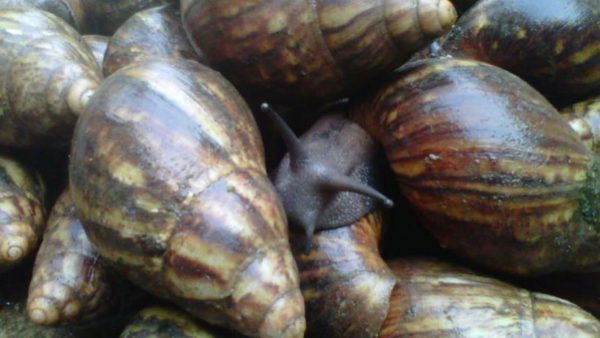How To Do Snail Farming In Nigeria

By Ayoola Olaitan
Shippers Guide is the learning page of MMS Plus newspaper. Here you learn the 5Ws and most important ‘H’ on various aspects of shipping. This week, we will take you through a detailed process of how to start a heliciculture business in Nigeria.
Enjoy it:
Heliculture (also known as Snail farming) is another lucrative business that is steadily growing as the commodity is in high demand across the country and beyond all thanks to the nutritious value the gastropod carry.
Snails are sold for their meat and are used in popular escargot dishes. To start and maintain a healthy snail farm, you’ll need to make sure that you get the right species of snails, create a favorable habitat, and care for the health of your snails. With patience and dedication, you can grow your snail farm from a personal hobby to a lucrative business venture.
Snail farming is not a new concept in agribusiness. Humans consume snail meat mainly because of its nutritional values. Snail is rich in protein and iron, low in fat and cholesterol, contains almost all the amino acid needed for the human body including Omega 3, no wonder this meat is always prescribed by medical experts to patients with failing health conditions.
Why Snail Farming?
The market opportunity for snail farming in Nigeria and in Africa is huge but grossly underrated. Snails are a huge part of the diet in many parts of Africa, although they are not always affordable and available all year round. If you rear snail in commercial quantity, hotels, and fast food restaurants will be your regular customers.
In Nigeria, the prices of raw, matured snails go for N250 to N600 depending on the size. However, the annual demand for snail in Nigeria is about 7.5million kg annually. The international trade in snails is flourishing in Europe and North America. The United State America imports more than $4million worth of snails annually from all over the world, including Nigeria.
For many years now, snails handpicked from the farm or bush has been the only way to get snails to the market and dinner table. Currently, the demand for snail is higher than the supplies, an indication that the market potential of snail is inexhaustible, locally and internationally. Starting both small and large scale snail farming businesses in the only way to fill up the spaces between the demand for snail and its supply in Africa.
How to Start a Snail Farm
Starting a snail farm for commercial purpose does not require a vast space of land but your choice of location is pertinent. Snails are best kept in cool area with leafy vegetables free of insects and pests.
The soil structure should be light; this helps the snail in egg laying and easy movement. Proper drainage system is important to allow for easy flow of water after rain. This will help to avoid stagnant waters around the farm.
For maximum result, it is advised to breed snails of the same species. There are different species of snails, and not all are suitable for snail farming meaning that some are more economical than the other. Also, not all specie of snail is consumed as meat. To have an active farm that will give the farmer optimum profit, I recommended you farm the Archachatina Marginata (Giant West Africa Snail) and achatina achatina (Giant Africa Snail). They are edible land snails that grow big and fast if supplied with enough food and housed in a professionally constructed snailery. There slime or muccus is also used by the cosmetic and pharmaceutical industries. While the Achatina snails lay small eggs 4-10 mm in diameter, in batches of 20 – 400, the Archachatina snails lay larger eggs 12-20 mm in diameter, in batches of 6 – 20.
How best to store snails
Snails can be stored outdoor or indoor but with controlled temperature (21 °C), humidity (75% to 95%) and in a moist area. Snail thrive more in damped environment.
You can make outdoor pens (snailery) where the snails are housed. When constructing the snailery (snail house), it should be made to be escape proof house and also effective against any predator to avoid loss. Materials used in constructing the snailery should be decay and termite resistant timber.
Also, the stage of development of the snail should be put into consideration when constructing your snail house. If possible, your pens should be covered with mosquito nets, this helps to prevent the snails from mosquito and other predators.
Feeding
Snails are generally vegetarians and accept most food types like fruits, leaves, flowers, tubers and any high calcium foods. Snails eat solid food by rasping it away with their radula. Feeding activity depends on the weather, and snails may not necessarily feed every day.
Just make sure the environment is tidy. Chop and drop the food for the snails in small quantity or make sizable bits of food and drop in the snailery giving spaces to avoid the snails clogging. To give the snail water, you just need to dampen/sprinkle the snailery or food with rain water or any ordinary water that is not treated with chlorine.
Modern snail farmers provide their snail with nutrition rich foods that help to enhance the growth rate and size.
How Snails Mate and Lay Eggs
One great and unique feature the snail has is that they are hermaphrodites, possessing both male and female organs and can choose which to be at any time. But even at that, the snail still needs to mate with another snail of same specie before it can lay eggs. Some snails could act as male in a season and in another female and fertilize each other simultaneously. Snails only mate at adulthood. Another nice feature of the snail is its ability to store sperm for up to a year but can lay eggs within few weeks after mating. The moist sand is suitable for laying eggs. After laying eggs, the snails lose its weight and some do not recover this weight. Some snails die after the breeding season.
According to some of our members that own snail farm, the first snails to hatch eat the shells of their eggs. This gives them enough calcium needed for their shells. They may then begin eating unhatched eggs. If the snail eggs are kept at the optimum temperature, 68 °F (for some varieties), and if none of the eggs lose moisture, most eggs will hatch within 1 to 3 days of each other. Cannibalism also will be low. If hatching extends over a longer period, cannibalism may increase. Some eggs eaten are eggs that were not fertile or did not develop properly, but sometimes, properly developing embryos might be eaten. A high density of “clutches” of egg masses increases the rate of cannibalism, as other nearby egg masses are more likely to be found and eaten. Snail egg has 12 to 20 times the protein of lettuce. The protein helps the baby snails start developing quickly and be healthier. Snail egg is an excellent starter food for newly hatched snails, but they tend to only eat eggs of their own species.
Snail Maturity Period
From the day the egg is laid, it approximately takes the snail 5 – 6 months to mature and 6 – 16 months to be sexually active (to produce)
“These snails grow up to 10 mm per month. After 6 months, the Achatina Fulica is about 35 mm long and may already be sexually mature. Sexual maturity takes 6 to 16 months, depending on weather and the availability of calcium. This snail lives 5 or 6 years, sometimes as many as 9 years.”– Wikipedia
Several factors can greatly influence the growth of snails. Some of these factors may include population density, stress (snails are sensitive to noise, light, vibration, unsanitary conditions, irregular feedings, being touched, etc.), feed, temperature and moisture, and the breeding technology used.
Contact of Expert Snail Farmer/Consultant
When starting out a new business, I always advise my readers to seek for a mentor, someone that will guide you on the best way to run the business. This mentor must be an expert in that niche you are about to enter, s/he must have seen it all in the business, excelled in the business and have evidence to this effect.
Cost of Starting A Snail Farming Business
The mandatory expenses you need to account for if you’re wondering how to set up a snail farm include: housing, buying fresh snails, feeding, handling and processing the snails, marketing, and transportation.
You can start the business with N60,000 or N100,000 depending on how large you want your snail farm to be. Asides the amount of your investment, it is possible to produce 1,000,000 snails now worth more than N5 million twice a year.
This is made possible because of the availability of very highly prolific Achatina achatina species of snails, which lay 200 – 400 in one batch two-three times a year. If you produce 100,000 snails that sell for N250 each, which is N250 X 100,000, you will be making N2,500,000. You will be making N25,000,000 per annum or more than that if you produce 1,000,000 snails.
For beginners, creating a snail farming business plan is a crucial step that needs to be accomplished before starting. This will give you a deep understanding of everything that needs to be done.
How to get buyers and make steady profit from Snail Farming Business
Getting buyers for your mature snails are never a problem; you just need to make the right contact while starting out. Depending on the scale you are operating, you just need to talk to few restaurants that specialize in snail meat, vendors that sell snails in the market, hotels and now most lucrative is selling to exporters. Some businesses might even order for snails even before maturity if you are good in growing snails to big sizes.
Exporting snail to other countries
As an entrepreneur, it is pertinent you explore all the options that will give you more profit in your business. Snail business is getting more lucrative by the day all thanks to the economic value of the animal. Apart from the fact that snails has great nutritional value, the snail slimeare used by cosmetic industry in preparing creams that help cure acne, anti-aging creams etc. The slime or mucus is also used by the pharmaceutical industries.
Live, frozen, chilled or prepared Snails can be exported to countries like France, USA, Indonesia, Japan, China, Netherlands, Greece, United Kingdom, Ireland, Poland and many other countries.
On how to go about the exporting procedures and packaging, you can also talk with Snail Farm Care. You can also get links of other exporters if you do not want to venture into exportation and be supplying them.
Conclusion
Snail farming (Heliciculture) is a very profitable business with bigger opportunities in the future. The mortality rate of snail is very low once kept in good condition and you will not be spending much on feeding cos snails don’t eat much and can go into hibernation for long hours. In all, it is a win-win for you if you are passionate about the business.
In terms of cost and time, snail farming is a low-risk business. Unlike many other livestock businesses, snail farming requires very little startup and operating costs. You can even set up your snail farm in the backyard of your house to save cost on the purchase of farmland.
The best time to start up a snail farming is the rainy season especially from July to October because that is the time snails normally start to breed. You should also note that prices of snails multiply during scarcity between March and December, which is the dry season.







